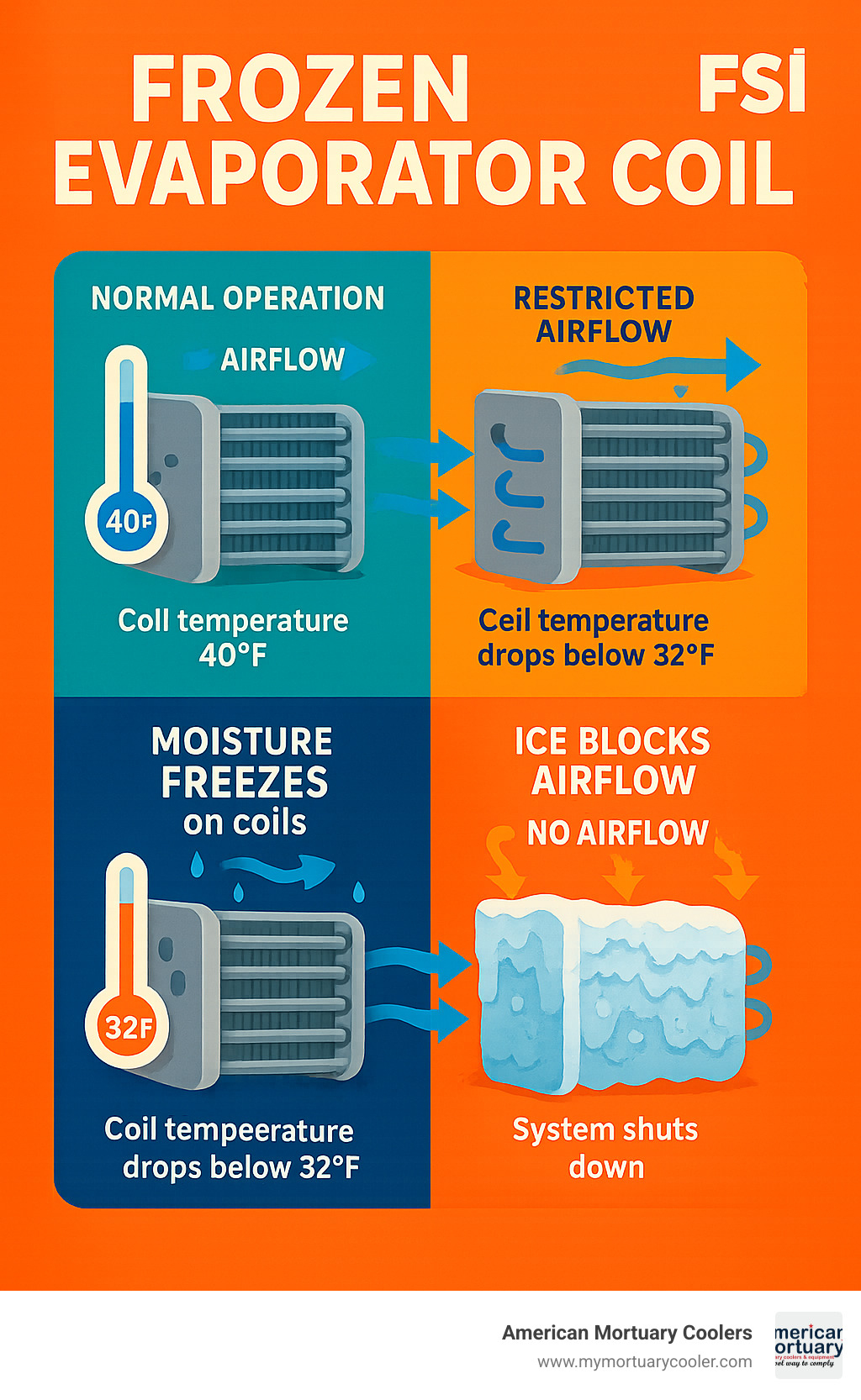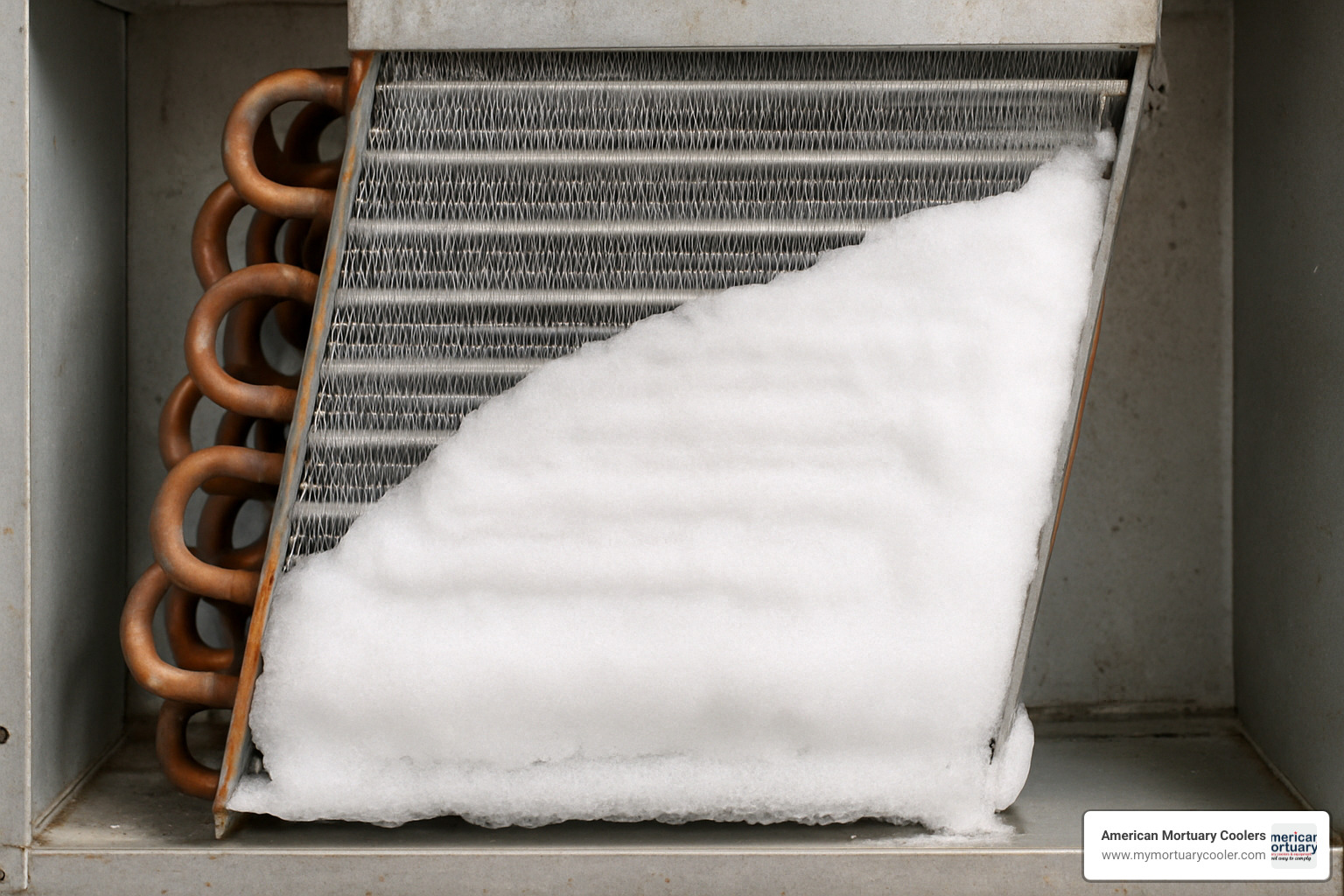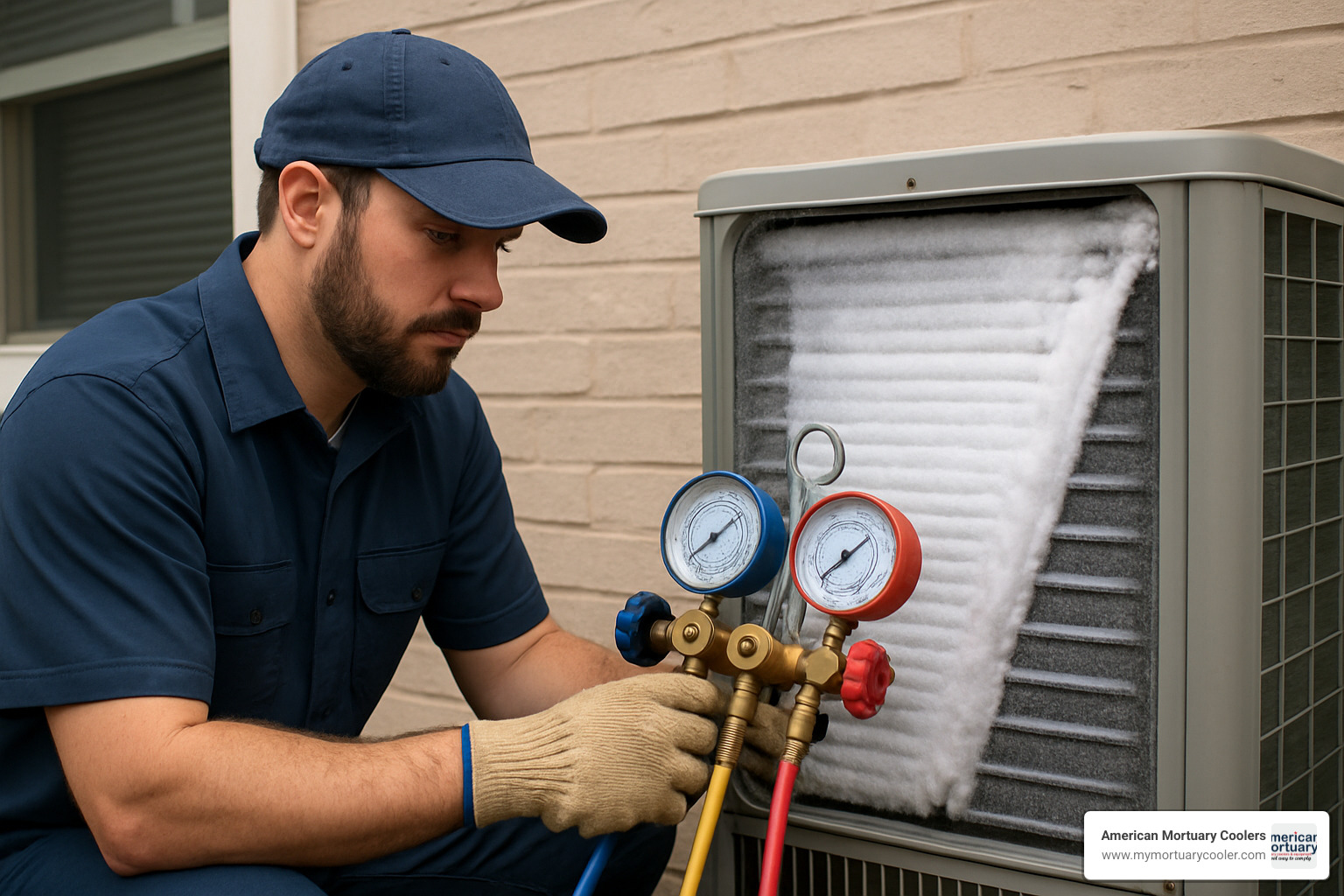Why a Frozen Evaporator Coil Stops Your Cooling System Dead
A frozen evaporator coil happens when ice forms on the metal coils inside your cooling system, blocking airflow and stopping heat transfer completely. Here's what you need to know:
Quick Fix for Frozen Evaporator Coil:
- Turn off your system immediately - running it causes expensive compressor damage
- Switch to fan-only mode to start thawing (takes 1-24 hours)
- Check your air filter - dirty filters cause 80% of coil freeze problems
- Look for these signs: no cool air, visible ice, water puddles, or hissing sounds
- Call a pro if: freezing happens repeatedly or you suspect refrigerant leaks
When moisture hits coils below 32°F, it freezes into an ice blanket that prevents heat absorption and forces your compressor to work dangerously hard.
Most frozen coils happen because:
- Dirty air filters restrict airflow (change every 30-90 days)
- Low refrigerant levels from leaks
- Blocked vents or return air paths
- Faulty thermostats or blower motors
I'm Mortuary Cooler, and I've spent years helping funeral directors solve refrigeration problems, including countless frozen evaporator coil emergencies. My experience with precision cooling systems has taught me that quick, proper action can save thousands in repair costs.

Frozen evaporator coil terms explained:
How AC Evaporator Coils Work & Why They Freeze
Your evaporator coil is the heart of your cooling system's heat-absorbing operation. This component sits inside your air handler, working continuously to pull heat from indoor air through a refrigerant loop process.
The refrigerant cycle works like this: your compressor pumps refrigerant vapor to the outdoor unit where it releases heat and turns to liquid. This liquid travels through copper tubing to your indoor evaporator coil, passing through an expansion valve that drops both pressure and temperature.
Under normal conditions, your coil maintains a saturated suction temperature around 40°F - cold enough to absorb heat but warm enough to stay above the 32°F freezing point. When warm indoor air flows over these cold coils at the right airflow rate, the refrigerant absorbs heat and turns back into vapor.
The balance between airflow and refrigerant temperature determines whether your system runs smoothly or turns into an ice block. When this balance breaks, your coil temperature drops below freezing.
For more details, see our Refrigeration System Basics guide.
What Is an Evaporator Coil?
Your evaporator coil looks like a metal radiator made from copper tubing with aluminum fins attached. These fins multiply the surface area for heat absorption, making your system efficient.
Most residential systems mount this indoor coil above your furnace or inside an air handler. When working correctly, warm air passes over the cold fins, heat transfers to the refrigerant, and your air gets cooler.
What Does a Frozen Evaporator Coil Mean?
A frozen evaporator coil transforms your cooling machine into a useless ice block. When moisture hits coil surfaces below 32°F, it creates an ice blanket that insulates instead of allowing heat transfer.
This triggers cascading problems. Ice blocks airflow, meaning less heat reaches the coil, causing more freezing. Your system enters a no-cool condition where it runs constantly but produces no cooling.
The real danger is compressor risk. Your compressor keeps working harder, but liquid refrigerant can flood back and destroy this expensive component.
How Restricted Airflow Leads to a Frozen Evaporator Coil
Restricted airflow creates perfect conditions for coil freezing. When airflow drops, less warm air passes over the coil. With less heat to absorb, coil temperatures fall below 32°F, and moisture freezes on metal surfaces.
Clogged filters cause 80% of airflow problems. Closed vents, weak blowers, and duct blockages create the same issue. Research on insufficient airflow confirms most freeze-ups trace back to preventable airflow restrictions.
Signs & Root Causes of a Frozen Evaporator Coil
A frozen evaporator coil often starts with small warning signs that build into a crisis. Recognizing these early symptoms can save thousands in repairs.
Warning Signs You'll Notice First
The most obvious sign is when your air conditioner runs constantly but your home stays warm. You'll feel warm air from vents instead of cold air.
Longer run times are another giveaway. Your system runs nonstop trying to reach thermostat settings. Listen for hissing noises from your indoor unit, and watch for water puddles around the unit as ice melts.
Reduced airflow from vents and increased humidity are other warning signs. If you can see ice on refrigerant lines or through access panels, you're dealing with serious freeze-up.
Top Causes and How They Interact
Rarely is it just one thing causing a frozen evaporator coil. Usually several issues combine to create freezing conditions.
Dirty filters are involved in 80% of freeze-ups. Clogged filters choke off airflow, dropping coil temperatures below 32°F.
Blocked return vents create similar problems. Refrigerant leaks cause remaining refrigerant to get colder in your coil. Bad fan motors reduce airflow like dirty filters.
Clogged drain lines increase humidity around coils. Cold outdoor temperatures below 60°F can trigger freezing. Thermostat problems can cause overcooling.
Diagnostic Checklist Before Taking Action
Before thawing, gather information about what caused the freeze-up.
Check temperature difference between return and supply air with a thermometer. Normal operation shows 12-15°F split. Higher splits indicate airflow problems.
Pull your air filter and do the light test. Replace if you can't see light through it easily.
Do a vent survey - ensure all supply registers are open and nothing blocks return vents. Look for visible ice on refrigerant lines or around your indoor unit.
DIY Step-by-Step Fix Guide

When you find a frozen evaporator coil, don't chip away at the ice! Most frozen coil situations can be safely resolved with patience and the right approach.
Immediate Safety Steps
Turn off your air conditioning at the thermostat first, then flip the breaker to your outdoor unit. Running your system with frozen coils can destroy your compressor, costing $2,000+ to replace.
When ice blocks your evaporator coil, liquid refrigerant can flood back to the compressor, causing "liquid slugging" that cracks internal components instantly.
Prepare for water mess with towels, buckets, or a wet vacuum. Heavy ice buildup can create several gallons of meltwater.
How to Safely Thaw the Coil
The safest method is switching to "fan only" mode. This circulates air over the coil without running the compressor.
Light ice buildup takes 1-4 hours. Heavy accumulation can take up to 24 hours. For faster results, use a hair dryer on low heat, 6+ inches away, moving constantly.
Never chip ice manually - you can puncture pressurized refrigerant lines. Avoid hot water, steam, or chemicals.
| Safe Thaw Methods | Risky Methods to Avoid |
|---|---|
| Fan-only mode (1-24 hours) | Chipping ice with tools |
| Hair dryer on low heat (6+ inches away) | Hot water or steam |
| Natural air circulation | De-icing chemicals |
| Patience and monitoring | High heat sources |
Post-Thaw Inspection & Restart
Once ice completely melts, replace your air filter immediately. Walk through and check all vents - move furniture from returns and open supply registers.
When restarting, set thermostat to 75-78°F. Don't try to "catch up" with extreme settings. After 15-20 minutes, check that cold air flows from supply vents with 12-15°F temperature difference.
Monitor closely for hours. If ice reforms, turn off and call a professional.
What to Avoid at All Costs
Running AC while frozen tops the mistake list. Adding refrigerant without diagnosis wastes money and masks other issues. Ignoring repeated freeze-ups indicates serious underlying problems needing professional repair.
Prevention & Maintenance Schedule

The best way to deal with a frozen evaporator coil is prevention. Regular maintenance prevents painful, expensive problems.
Regular Tasks Homeowners Can Do
Filter changes every 30-90 days are critical - dirty filters cause 80% of freezing problems. Set reminders and stick to them. Pet owners and dusty areas need monthly changes.
Keep vents clear with seasonal home walk-throughs. Move furniture from return vents and keep supply registers open (never close more than 25%).
Outdoor unit maintenance means keeping 2+ feet clearance, trimming bushes, removing debris, and gentle coil cleaning.
Smart thermostat habits prevent freeze-ups. Never set below 68°F, especially at night. Use programmable thermostats for steady temperatures.
Monthly drain line cleaning with white vinegar prevents clogs that create humidity problems.
Pro-Level Services That Pay Off
Annual professional tune-ups catch small problems before emergencies. Technicians check refrigerant, clean coils, calibrate thermostats, inspect blower motors, and verify airflow.
Refrigerant service requires EPA-certified professionals. Professional coil cleaning removes stubborn buildup. Duct evaluation ensures proper airflow balance.
Freeze protection sensors can be added to problem systems, monitoring coil temperature and shutting down before ice forms.
For more maintenance insights, check our How to Control Temperature guide.
Costs, Professional Help & FAQs

When your frozen evaporator coil needs professional help, repair costs range from $150 service calls to thousands if your compressor gets damaged.
How Much Will It Cost to Fix?
Basic diagnostic service calls run $150-$300, often waived if you proceed with repairs. Leak detection and repair costs $300-$800, plus $200-$500 for refrigerant.
Airflow problems vary widely. New blower motors cost $400-$800, while ductwork repairs run $500-$2,000. Professional coil cleaning costs $200-$400.
Compressor replacement from freeze damage costs $2,000-$4,000 - often better to replace the entire system.
Prevention costs much less: quality filters cost $20-$100 yearly, maintenance contracts run $200-$400, smart thermostats cost $200-$500 upfront. Research on frozen coil costs shows preventive maintenance costs 10% of major repairs.
When Should You Call a Professional?
Call immediately for repeated freezing after basic fixes, suspected refrigerant leaks (hissing sounds, oily residue), or electrical problems.
Ice formation when outdoor temps exceed 70°F indicates major component failure. Multiple failed DIY attempts mean professional diagnosis is needed. Check warranty terms before DIY repairs.
Frequently Asked Questions
How long does it take a frozen coil to thaw?
Light ice melts in 1-4 hours with fan-only mode. Heavy ice takes up to 24 hours. Humidity and ice thickness affect timing most.
Can a frozen AC fix itself if left alone?
No - while ice melts when you turn off the system, the underlying cause remains. Without fixing root causes like dirty filters or low refrigerant, you'll face repeated freeze-ups.
What happens if I ignore a frozen evaporator coil?
Compressor damage from liquid refrigerant flooding. Energy waste as systems work overtime without cooling. Mold growth from melting ice. Water damage when ice overwhelms drain systems. A $50 filter replacement can become $5,000 system replacement if ignored.
Conclusion
Dealing with a frozen evaporator coil doesn't have to be overwhelming. Turn off your system immediately, let it thaw properly, and tackle the root cause - often just a dirty $20 air filter.
The key is learning from the experience. Once you've safely thawed your coil and identified the cause, you're ahead of most homeowners who just hope it doesn't happen again.
At American Mortuary Coolers, reliable refrigeration isn't optional - it's critical. When funeral directors depend on our custom cooling solutions, there's no room for "maybe it'll work." This systematic approach applies whether protecting mortuary environments or home comfort.
Regular maintenance costs a fraction of emergency repairs. Change filters, keep vents clear, and schedule annual tune-ups. Some problems require professional expertise - there's no shame in calling qualified technicians.
For cooling system insights and commercial applications, explore our Walk-In Coolers guide. Whether managing residential comfort or critical commercial cooling, proper system care fundamentals remain the same.
Treat your cooling system with respect, maintain it properly, and it'll serve you reliably for years. If you face another frozen coil situation, you'll know exactly what to do.


















